As an Amazon Associate I earn from qualifying purchases.
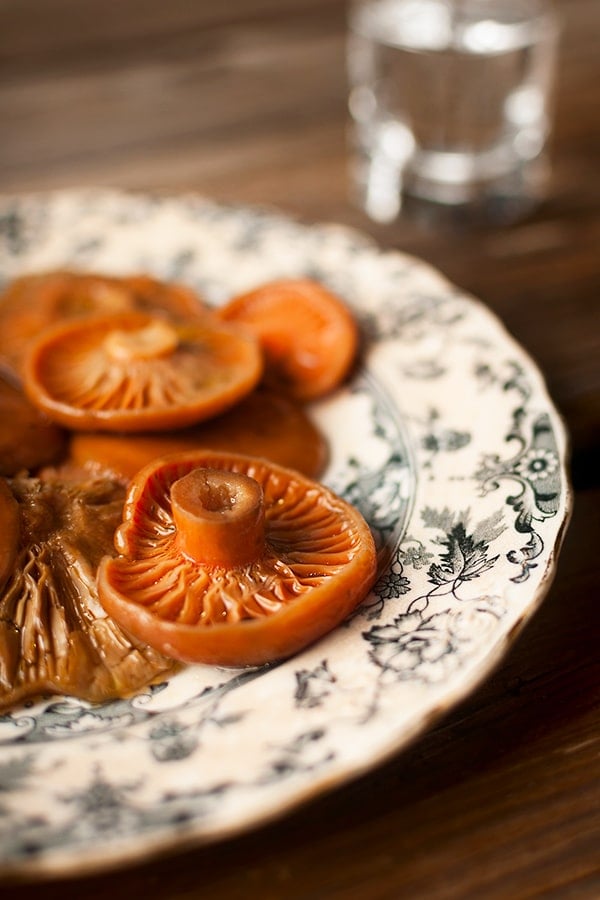
If you think fermented mushrooms sounds, well, unappetizing, think again. Walk with me a moment…
Every time I take a newcomer out mushroom hunting, we come across various quasi-edible mushrooms, notably members of the russula family. “Are these edible?” they ask. Well… the Russians eat ’em, I’ll say, usually salted and then pickled. Even the well-named “emetic” russula mushrooms can be rendered edible by this method, I’ll say.
“Well, are they good that way?” That’s when I had to admit that um, well, actually I’d never done it.
Now I have. Turns out fermented mushrooms is a popular way to preserve them all over the Slavic world, but I’d always been a little leery of it for vague reasons, mostly having to do with fears of listeria or heat-volatile mycotoxins that salting won’t denature.
A little research turned up that there indeed have been several poisonings related to the Russian method of salting mushrooms. Even my colleague Sandor Katz in his mega-awesome book The Art of Fermentation hesitates when writing about lacto-fermented mushrooms.
Because so little research has been done on mushroom fermentation, I would recommend cautious experimentation.
Not exactly a ringing endorsement from the usually enthusiastic Katz.
I knew about a Russian salted mushroom recipe before I read Katz’s book, and in fact he cites it: It’s from Anne Volokh’s The Art of Russian Cuisine. I started with that recipe.
But which mushrooms to use? I didn’t want to start with russulas. But I didn’t have to. As it happens, there is another mushroom that is prized for this method above all others: Lactarius deliciosus, the saffron milk cap.
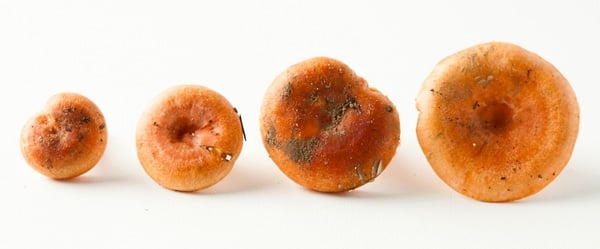
Mostly I find this mushroom after its aged to the point of nastiness. When they get old or are bruised, this mushroom stains puke green. Blech. But fresh and young, they are a sunny, welcoming orange with pretty concentric rings on their caps. Eaten like a regular store-bought mushroom, however, saffron milk caps are pretty disappointing: They are grainy and not terribly flavorful. Maybe they’d improve once salted down?
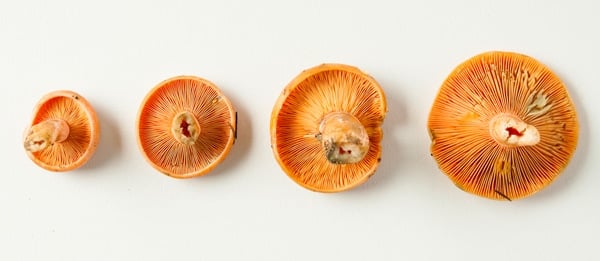
So one day, after I came home with a pound or so of pretty milk caps, I made Volokh’s recipe. You basically salt down the mushrooms with garlic and other spices, then put a plate over them and weigh it down. Doing this squashes the mushrooms and that, combined with the salt, pulls out their water and forms a brine. They then ferment for a week or two before you eat them.
I did this, but the first thing I noticed was that the mushrooms turned a dingy brown.
I was still pretty leery of them, so just to be sure I boiled some brine and poured the boiling brine over the mushrooms. There they sat in my fridge uneaten. A few days later, I bought another book, Polish Heritage Cookery. Paging through it, I noticed that it too had a salted mushroom recipe, grzyby kwaszone. Unlike the Russian version, this one requires you to boil the mushrooms for a few minutes first. Aha! This seemed far more sensible.
So I went out and got some more milk caps. This time, when I boiled them, their pretty orange color held! I fermented them in the same way as I did with the Russian ones, but once these were done they kept their color. I don’t know if it was the color or the boiling that made me want to eat these mushrooms, but I suddenly felt more at ease.
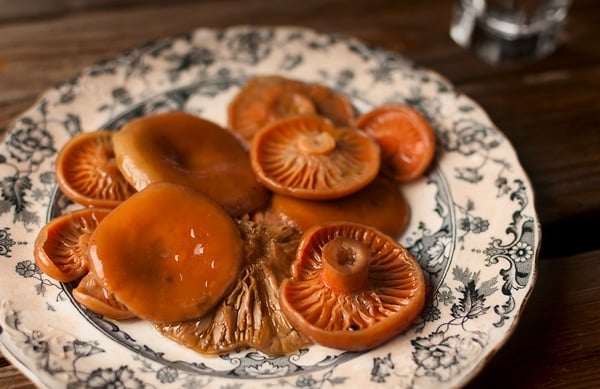
Slavs typically eat their salted mushrooms with bread and vodka. I know, this must shock you, but really, they do drink vodka on occasion. So I got some good rye bread and poured myself a shot of vodka. Here goes…
Wow! While the grainy texture of a sautéed saffron milk cap is nasty, once salted and fermented, the texture become meaty and pleasant. You can definitely taste the garlic and juniper, but the mushrooms were salty. Really damn salty. Volokh says they are often soaked in fresh water for a few minutes before they’re eaten, and I see why.
This recipe is definitely worth trying, especially if you combine the mushrooms with good dark bread and some beer, vodka or akavit.
Na zdrowie!
Polish Fermented Mushrooms
Ingredients
- 3 to 4 pounds fresh mushrooms, cleaned and stems removed
- Kosher or pickling salt
- 6 to 10 juniper berries, crushed (optional)
- 1 teaspoon dried dill, or 2 tablespoons fresh
- 1 teaspoon caraway seed
- 2 teaspoons cracked black pepper
- 2 garlic cloves smashed
Instructions
- Boil the mushrooms in salted water for 5 minutes. Drain and let them cool in one layer on a paper towel or tea towel.
- Mix all the herbs and spices in a small bowl. Lay down a thin layer of pickling or kosher salt at the bottom of a crock or other non-reactive container, then lay down a layer of mushrooms. Sprinkle with some of the herbs and spices. Add a bit more salt. Keep layering like this until you have all the mushrooms in the crock. Finish with another layer of salt.
- Place a clean plate or other top on the mushrooms and weigh it down. I use a quart Mason jar filled with water. Let this sit in a cool, dark place (no need to refrigerate) for 4 days. After the first day, check to see that the mushrooms are submerged in their own brine. If not, boil 1 pint of water with 2 tablespoons kosher salt and let it cool. Pour over the mushrooms and continue fermenting.
- After 4 days, move the mushrooms and brine and spices to clean Mason jars and refrigerate. They will keep for several months.
Notes
Nutrition
Nutrition information is automatically calculated, so should only be used as an approximation.

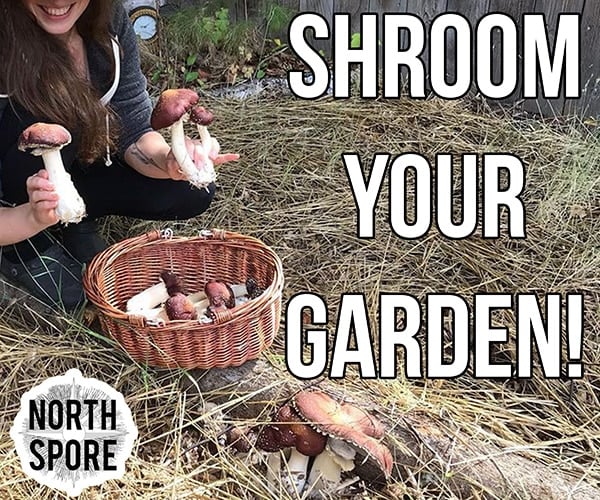
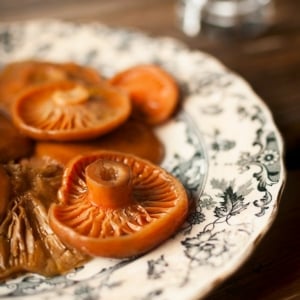
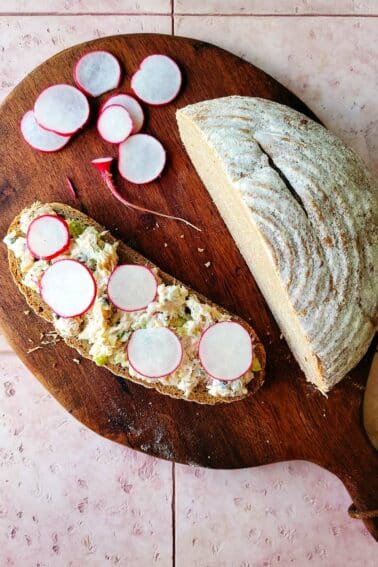
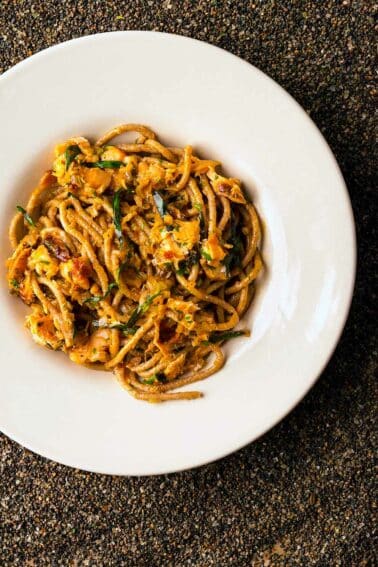
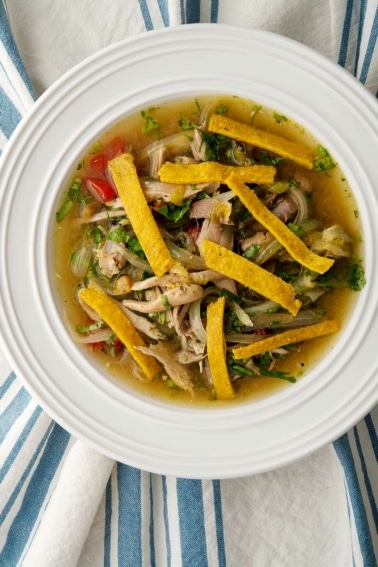
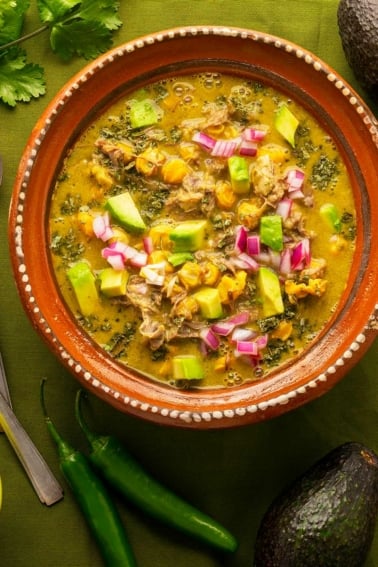
I’m thinking about trying this recipe with lobsters. Seems like it would be a good fit since they grow on russulas/milk caps. I can’t stand their grainy texture. Hoping this will help. Maybe too much funk for the disco? Anybody try this?
JB: I think it’ll work, because the lactaria I normally use are also grainy when fresh.
How much salt do you put in the water when you boil them?
Sheila: I never measure. It’s like pasta water, salty but not crazy salty.
I’ve been making this recipe every year for about 5 years now, since I came across this article. Great addition to a charcuterie board or as a side anywhere I’d typically have olives. I primarily use Lactarius rufus since it’s abundant on the WA coast in the late fall, (commonly used through Scandanavia & Russia) parboiled twice to remove the intense peppery flavor, but have also done Lactarius deliciosus with great results. Still haven’t branched out to the Russulas, but probably will at some point!
I am new to this wonderful world of fermentation – My grandmother used to pickle everything. Sadly she is no-longer alive. I have a question regarding the Russian KVASS (fermented Beets) can i add Mushrooms to them? I have this idea of using Dried Porcini Mushrooms – pulsate them into a powder and adding them to my KVASS (beets) for flavour. Is this dangerous?
Balina: I have no idea. I would not do it, though.
I am probably late but kvas is not fermented beets! Kvas is a drink from rye bread, it does not have any beets or mushrooms.
There are lots of versions of kvass all over Eastern Europe. Some have beets, some have mushrooms.
I think I must have made these mushrooms at least 10 times and they have been absolutley delicious every single time. Love ’em! So far, I have mainly used chestnut mushrooms, but I now have access to Shiitake mushrooms, and cultivated ‘woodland’ mushrooms, which I shall give a try next time… Great recipe, very tasty! Thank you!
how much water and how much salt?
Bryan: Enough. There is no set amount. If you follow the recipe, you are laying down a little salt for each layer of mushrooms. You only add water if the mushrooms don’t exude enough to cover themselves. These will turn out salty, but that’s the point.
I get pine rings (what you call milk caps) in South Africa in autumn. They are a delicious mushroom! I am curious about the bad texture you refer to.
I don’t know where or how old the mushrooms you get are but saffron milkcaps are wonderfully flavourful and versatile. Sauteed in butter or in a marsala cream sauce with paste, in chicken chasseur, mushroom pate, or breadcrumbed and deep fried or Spanish pine mushroom and potato stew. These mushrooms are so versatile i harvest them by the hundreds on my property in rural Australia. To see them described in such negative terms is disappointing.
David: To each his own.
Hi, I am first gen Russian and we often make salted russulas (including the emetic ones). We have always peeled the colorful skin on top off, boiled them briefly, drained, and rinsed them prior to salting them. We then add garlic and dill to the brine, drain most of the brine liquid off, and leave on the counter overnight under a press. This is known as the “hot” salt fermentation method.
There is a way to salt ferment mushrooms using a “cold” salt fermentation method as you described but it is usually done with a large quantity of mushrooms (at least a small bucketful) that are pre-soaked and ferment for a longer period. Our family doesn’t do this but it can be done if you know what you are doing.
Traditionally, all forest mushrooms are boiled (or at least parboiled) prior to cooking. The cold salt fermentation method is the only exception I know of to this.
I’m including a video of how Russians prep russalas for cooking. The skin is peeled off as it’s said to be emetic. We then briefly boil them, drain, rinse, and salt or use in a mixed forest mushroom soup or other mixed mushroom dishes.
https://m.youtube.com/watch?v=DvDyeWC-RGs
Just wanted to add that we LOVE your ghetto confit recipe and have made it a million times over the years!
I must have missed a simple step here. When you put the mushrooms in the crock and cover them with the plate and weight do you then cover them again with the crock top? I tried this and did not cover them and I have mold now. Any insight? Thanks very much.
Ed: Weird. I never get mold, as I only ferment a couple days. Were the mushrooms submerged in their own brine? They need to be under the brine. Anything growing on top of the brine is fine. You just skim it off.
Thank you for your blog and the recipe! This sounds like what my mom used to cook. If you have very bitter or spicy milk caps, soak them in cold water for a day or two before boiling. You need to change their water every few hours. If it’s hot where you are soaking the mushrooms, put the container (water and all) into a fridge overnight.
Hank- I found a milkcap species in the Midwest that no one can identify. I was told to taste one as flavor is a distinguishing characteristic with milkcaps. So first I tasted the sap and then the mushroom. it tasted like a cooked shaggy mane- deep mushroom flavor. I was told that it’s probably is safe to eat. So I will follow this recipe and see what happens. I have already dried the mushrooms. I was wondering if I should boil the brine and mushrooms together or just the brine and assume they will re-hydrate over the 4 days? I also plan to eat only 1 bite and wait 24 hrs before eating anymore- no great desire to play mushroom roulette.
Do all mushrooms that you want to pickle need to be cooked or can I simply brine button mushrooms without any fear that the brining will enhance any mild toxicity mushrooms may have? Thanks
Bernard: Store-bought button mushrooms shouldn’t need to be boiled, but I might just for the hell of it. Can’t hurt.
Does this method of pickling The mushrooms allow for storage without having to refrigerate them?
Ayla: not really. But I bet you could keep them in a cool basement or root cellar though.
How do you eat them after pickling? wash them?
Cook in butter maybe? Or as they come out of the jar./pot.
Pixie: I rinse them and put in a new brine in a jar. They last in the fridge a long time that way.
What is the rough proportions for the new brine you use when you store them? Thanks. Just made these in Whitehorse Yukon and LOVE them.
Christine: Same. 1/4 cup kosher salt to 1 quart of water. And I’m glad you like them!